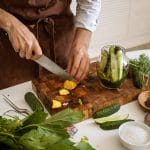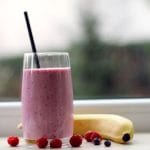Blenders are highly versatile kitchen appliances that can be used for a wide range of tasks, such as making smoothies, emulsifying sauces, making salad dressings, and pureeing vegetables. However, we often assume these trusty devices to be invincible, although that is rarely the case.
Yes, you can use a portable mini blender to accomplish several tasks, but there are plenty of things you should never use your portable mini blender for unless you want a blender disaster on your hands. In this article, we will highlight various foods and items that you should keep away from your portable mini blender.
Never Use Your Portable Mini Blender for These Things
You will read about several things that you might put in your blender on a daily basis without any negative consequences. Remember when you read about them, that broken blade tips aren’t the only things that can spell blender disaster.
Certain things can damage or wear out your portable mini blender more subtly, like ruining or tainting the container’s rubber seal. Equally important is the fact that sometimes the opposite can also happen when the blender ruins the food you’re making.
Here’s our list of things to avoid putting in a portable mini blender!
1. Hot Liquids
You should avoid putting anything super hot in your portable mini blender, whether solid or liquid. In fact, it’s also not safe to put hot liquids in a regular kitchen blender. Super hot foods give off a lot of steam which cannot get trapped in the blender. When you tightly secure the lid and pulse the contents, the steam rapidly expands and results in pressure build-up.
Consequently, you will have an explosive disaster on your hands, which can burn your hands or ruin your kitchen’s countertop. Whenever you want to puree or emulsify hot foods and liquids, consider using an immersion blender instead of closed top blenders, increasing the pressure inside the container.
2. Nuts and Dry Fruits
While you can use whole nuts and dried fruits when making smoothies, you should never use your portable mini blender to blend them. Although your traditional blender might have no problem slicing and grinding up the leathery and sticky dried fruits, your portable mini blender will quickly become useless.
Dried fruits can get stuck on the blades of your blender and reduce its performance. Over time, the build-up can render them utterly useless by covering the sharp edges. Similarly, whole nuts also pose an identical problem. While your bender won’t have any issue grinding them, they will dull the blade’s edges and reduce its performance over time. However, there’s a simple solution for this issue. Whenever you need to use dried fruits or nuts in a recipe, either chop them up into tiny bits using a kitchen knife or soak them in warm water to soften them up. You won’t run the risk of damaging the blender blades in this way!

3. Frozen Fruits
It’s common to freeze extra fruits and vegetables in a Ziploc bag for storage purposes. It’s even more common to use them in simple smoothie recipes directly out of the freezer. Never use your portable mini blender with frozen foods as they can damage the blade and container.
In the worst-case scenario, the super-frozen fruits will strike the container walls and break them, spraying sharp shards of glass and plastic all over the kitchen. Avoid putting frozen food in a blender unless you want to spend hours pulling glass pieces out of kitchen utensils or cleaning splattered food from the kitchen floor and walls.
Similarly, the blades of portable blenders are not nearly as strong as a regular blender and can break when blending super-frozen fruits. Shards and tiny bits of metal can even get stuck in processed food and result in medical emergencies.
Even when your blender doesn’t entirely self-destruct, blending frozen fruits results in lumpy smoothies with random chunks of frozen fruit that are difficult to bite or chew. If you want to use those frozen blueberries in your banana smoothie, consider thawing them in water first!
4. Coffee Beans
You should preferably grind coffee beans in a coffee grinder to achieve uniform powdered grains. Although not recommended, you can grind coffee beans in a blender in small amounts to maximize contact with the blades. However, two important things happen when you do this.
First, the coffee grounds will not be uniform, which will ruin the grounds’ flavor profile. Second, the coarse coffee beans will dull the blades over time, so you’re better off sticking to a coffee grinder.
5. Ice Cubes
Never use your portable mini blender for crushing ice cubes. Much like blending frozen fruits, ice cubes can damage the sharp edges of the blender’s blade or even break them. Similarly, you might also break the glass or plastic container because of the ice cubes.
Consider using robust kitchen blenders that are specialized to crush ice and frozen foods. However, it would be best to use ice that’s already crushed when blending smoothies or making juices.
6. Bones
Bones and meat with bones should never be put into a portable mini blender. Large bones, such as those in beef and mutton, can dull the blender blades, break their tips, and even damage the container itself.
Similarly, blending bones can also jam the blender or result in splintered bone pieces getting stuck in the food, which can get lodged in your throat or cause other health concerns.
7. High-Fiber Foods
Food rich in fiber, like green vegetables, is excellent for living a healthier lifestyle. However, it’s not an ideal choice for your blender. Fibrous vegetables can jam the blades of a mini portable blender and reduce its performance and efficiency.
On the other hand, the blender doesn’t do the vegetables any favors either. The rapidly revolving blades can quickly brown raw celery and broccoli or turn them into strings of fiber. A mini portable blender will also turn certain super high-fiber foods into a mushy mess, so it’s best to cook or soften them before turning to your blender.
8. Kitchen Utensils
Never use your portable mini blender while having kitchen tools in the container. You must think that’s a no-brainer, but it’s very easy to forget or overlook specific details while working in the kitchen. Plastic, glass, and wooden utensils can chip or crack in a blender and ruin your meal, wasting precious time. It’s best to keep an active mind when working in the kitchen, especially when using blenders.
9. Foods with Strong Flavor and Odor
This entry doesn’t result in broken blades or a damaged blender, but it can undoubtedly affect the rubber seal of your blender and trap strong odors in the container. Foods like raw garlic have a strong flavor and aroma, which is challenging to wash or rinse out of the container thoroughly. You might notice this when blending a smoothie right after using your blender to prepare that steak marinade. It would be best if you only used your portable mini blender for similar tasting foods or those that don’t release intense flavors or odor into the container.
10. Potatoes
Potatoes are among the most starchy foods people enjoy eating. However, too much starch can ruin the texture of the food and leave a weird taste in your mouth. Using a blender for potatoes is a big no-no as the super-fast blades can overwork the potatoes, causing them to release too much starch; this will result in a mushy, unappealing paste.
It would be best to never use your portable mini blender for starchy foods; instead, stick to a masher or ricer.
Conclusion
A portable mini blender is a multi-purpose and highly versatile appliance, perfect for blending smoothies and pureeing vegetables, but even this device has its limits. It would help if you never used your portable mini blender for the aforementioned foods.
There are plenty of other foods that you shouldn’t put in a blender, but the ones we’ve mentioned neatly summarised the different food types you should aim to avoid. Doughs, gingers, and powdered foods are other important types that you should look out for when using a blender.
In short, do your portable mini blender a favor and read the instruction manual to get a complete grasp of what things you can put in it without fear of damaging the blades or breaking the container. We hope you found our article informative and helpful!







